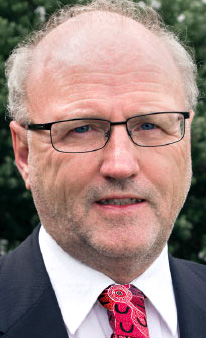

 It might appear paradoxical for Google to buy a company for $12 billion and to then not move into that business, but I believe this is the strategy supporting that company's purchase of Motorola Mobility. As many have already pointed out, the value of Motorola resides in its patents. For more than a decade this company has been a fading star... more
It might appear paradoxical for Google to buy a company for $12 billion and to then not move into that business, but I believe this is the strategy supporting that company's purchase of Motorola Mobility. As many have already pointed out, the value of Motorola resides in its patents. For more than a decade this company has been a fading star... more
The U.S. Federal Communications Commission has proposed fines against the country's four largest wireless carriers for apparently selling access to their customers' location information without taking reasonable measures to protect against unauthorized access to that information. more
 One of the biggest telecom events in the world, now in its tenth year, the GSMA Global World Congress, is attracting 90,000 visitors this year. Why are so many people flocking to this event? Obviously telecoms and mobile in particular, has become one of the biggest industries in the world. Hundreds of billions of dollars are invested every year and the market simply keeps growing. However, that alone is not enough to explain this large number of visitors. more
One of the biggest telecom events in the world, now in its tenth year, the GSMA Global World Congress, is attracting 90,000 visitors this year. Why are so many people flocking to this event? Obviously telecoms and mobile in particular, has become one of the biggest industries in the world. Hundreds of billions of dollars are invested every year and the market simply keeps growing. However, that alone is not enough to explain this large number of visitors. more
 One of the great challenges has been to conceive a business model for next generation telephone companies. This is constrained by their limited core competences which do not match well with many of the opportunities that lie in entertainment and complex/customised bundles for consumers. Frost & Sullivan, a leading firm of industry analysts, notes the enthusiasm of service providers to offer connectivity, entertainment and information services, within a digitally connected world... more
One of the great challenges has been to conceive a business model for next generation telephone companies. This is constrained by their limited core competences which do not match well with many of the opportunities that lie in entertainment and complex/customised bundles for consumers. Frost & Sullivan, a leading firm of industry analysts, notes the enthusiasm of service providers to offer connectivity, entertainment and information services, within a digitally connected world... more
 There is some good news about the decision by Verizon Wireless to offer shared monthly data plans. But there could be a lot more if the FCC applied its Carterfone policy. That policy gave consumers the power to decide what and how many devices to attach to a network connection. If Carterfone applied, consumers could use multiple devices to access a network subscription, albeit perhaps not at the same time. more
There is some good news about the decision by Verizon Wireless to offer shared monthly data plans. But there could be a lot more if the FCC applied its Carterfone policy. That policy gave consumers the power to decide what and how many devices to attach to a network connection. If Carterfone applied, consumers could use multiple devices to access a network subscription, albeit perhaps not at the same time. more
 Do you know someone who has played a major role in the development and advancement of the Internet? Now is the time to recognize their contribution. Nominate them for the 2019 Internet Hall of Fame. With more than 100 inductees, the Internet Hall of Fame celebrates Internet pioneers and innovators who have pushed the boundaries to bring the Internet to life and make it an essential resource for billions of people today. more
Do you know someone who has played a major role in the development and advancement of the Internet? Now is the time to recognize their contribution. Nominate them for the 2019 Internet Hall of Fame. With more than 100 inductees, the Internet Hall of Fame celebrates Internet pioneers and innovators who have pushed the boundaries to bring the Internet to life and make it an essential resource for billions of people today. more
 Over the past few days, Microsoft made two major announcements. One was a "playbook [for] providing a carrier-grade platform for edge and cloud computing to help network operators realize the full potential of 5G technology" using its it Azure cloud data centres. The second announcement was a new platform that enables satellite-based access to those same cloud data centres designated Azure Orbital. Coupled with these announcements was another one by Samsung... more
Over the past few days, Microsoft made two major announcements. One was a "playbook [for] providing a carrier-grade platform for edge and cloud computing to help network operators realize the full potential of 5G technology" using its it Azure cloud data centres. The second announcement was a new platform that enables satellite-based access to those same cloud data centres designated Azure Orbital. Coupled with these announcements was another one by Samsung... more
 It is interesting to follow what is happening with triple and quadruple play broadband prices in competitive markets. Through triple and quadruple play, customers are increasingly getting more services for the same money. As most fixed telecoms markets are still largely monopolistic in nature, basic access charges remain high; but good prices are even available in markets with healthy wholesale competition, if one shops around. more
It is interesting to follow what is happening with triple and quadruple play broadband prices in competitive markets. Through triple and quadruple play, customers are increasingly getting more services for the same money. As most fixed telecoms markets are still largely monopolistic in nature, basic access charges remain high; but good prices are even available in markets with healthy wholesale competition, if one shops around. more
 The POPClock tells us that there are 6,807,230,170 of us on this planet when I looked it up at 22:26 UTC (EST+5) Feb 26, 2010. In the meantime we are about to connect the 5 billionth cell phone user this year according to ITU Secretary-General Dr. Hamadoun Toure.
The POPClock tells us that there are 6,807,230,170 of us on this planet when I looked it up at 22:26 UTC (EST+5) Feb 26, 2010. In the meantime we are about to connect the 5 billionth cell phone user this year according to ITU Secretary-General Dr. Hamadoun Toure.
more
 Lee Dryburgh initiated a great thread in the Emerging Communications public group entitled What would your perfect phone be? There are 14 messages there at this moment with a lot of good ideas, but my first thought was the term "phone" is too limiting. Indeed, some of the correspondents' ideas also go far beyond the idea of a telephone. Here's what I want and fully expect to see, eventually. more
Lee Dryburgh initiated a great thread in the Emerging Communications public group entitled What would your perfect phone be? There are 14 messages there at this moment with a lot of good ideas, but my first thought was the term "phone" is too limiting. Indeed, some of the correspondents' ideas also go far beyond the idea of a telephone. Here's what I want and fully expect to see, eventually. more
 The explosion in mobile communications in the developing world has created social and economic changes that have exceeded all expectations and predictions -- even those made as recently as five years ago. There are still countries lagging behind, but now is the time to move on to the next stage -- and that means broadband. Already the developed world is showing an enormous appetite for mobile broadband, so the demand is most certainly there. The rapid development of low cost Smartphone, projected to approach $50 soon... more
The explosion in mobile communications in the developing world has created social and economic changes that have exceeded all expectations and predictions -- even those made as recently as five years ago. There are still countries lagging behind, but now is the time to move on to the next stage -- and that means broadband. Already the developed world is showing an enormous appetite for mobile broadband, so the demand is most certainly there. The rapid development of low cost Smartphone, projected to approach $50 soon... more
 I'm happy to have the option of buying services. It's easier to eat at a restaurant than to do my own cooking, and I'm happy to pay for a ride rather than fighting traffic on my own. However, I'm not happy if I don't have the option of cooking for myself or of taking a stroll. I used to be willing to pay for all of my phone calls but today I know that, thanks to VoIP, there is no need to. But the phone companies are attempting to wrest back control with their wider 5G agenda. more
I'm happy to have the option of buying services. It's easier to eat at a restaurant than to do my own cooking, and I'm happy to pay for a ride rather than fighting traffic on my own. However, I'm not happy if I don't have the option of cooking for myself or of taking a stroll. I used to be willing to pay for all of my phone calls but today I know that, thanks to VoIP, there is no need to. But the phone companies are attempting to wrest back control with their wider 5G agenda. more
 Apple Computer has received high praise for the diversity of applications available for the iPhone. The company shows great willingness to accept third party software innovations. But Apple also solely decides whether to accept and make available any application. Rejected software vendors for the most part do not exist if they do not have shelf space at the Apple store. more
Apple Computer has received high praise for the diversity of applications available for the iPhone. The company shows great willingness to accept third party software innovations. But Apple also solely decides whether to accept and make available any application. Rejected software vendors for the most part do not exist if they do not have shelf space at the Apple store. more
 The enormous growth in mobile usage, doubling each year, is set to continue for several years in a row. According to Ericsson, by 2020 mobile operators will need to provide one thousand times the capacity that was required in 2010. Our assessment at BuddeComm is that the mobile industry has already fallen behind in delivering the capacity needed today, let alone coping with the enormous growth ahead; and that this situation will deteriorate before it improves. more
The enormous growth in mobile usage, doubling each year, is set to continue for several years in a row. According to Ericsson, by 2020 mobile operators will need to provide one thousand times the capacity that was required in 2010. Our assessment at BuddeComm is that the mobile industry has already fallen behind in delivering the capacity needed today, let alone coping with the enormous growth ahead; and that this situation will deteriorate before it improves. more
 Mobile networks aren't usually thought of as sources of spam, but a quick look at some of the resources that track spam reveals they actually are. This is counter intuitive at first glance because when most people think of mobile they think of smartphones, and those aren't known to be sources of spam (at least not yet). What's really going on is PCs connected to mobile networks with air cards, or tethered with a smartphone where it's permissible, are the culprits more
Mobile networks aren't usually thought of as sources of spam, but a quick look at some of the resources that track spam reveals they actually are. This is counter intuitive at first glance because when most people think of mobile they think of smartphones, and those aren't known to be sources of spam (at least not yet). What's really going on is PCs connected to mobile networks with air cards, or tethered with a smartphone where it's permissible, are the culprits more